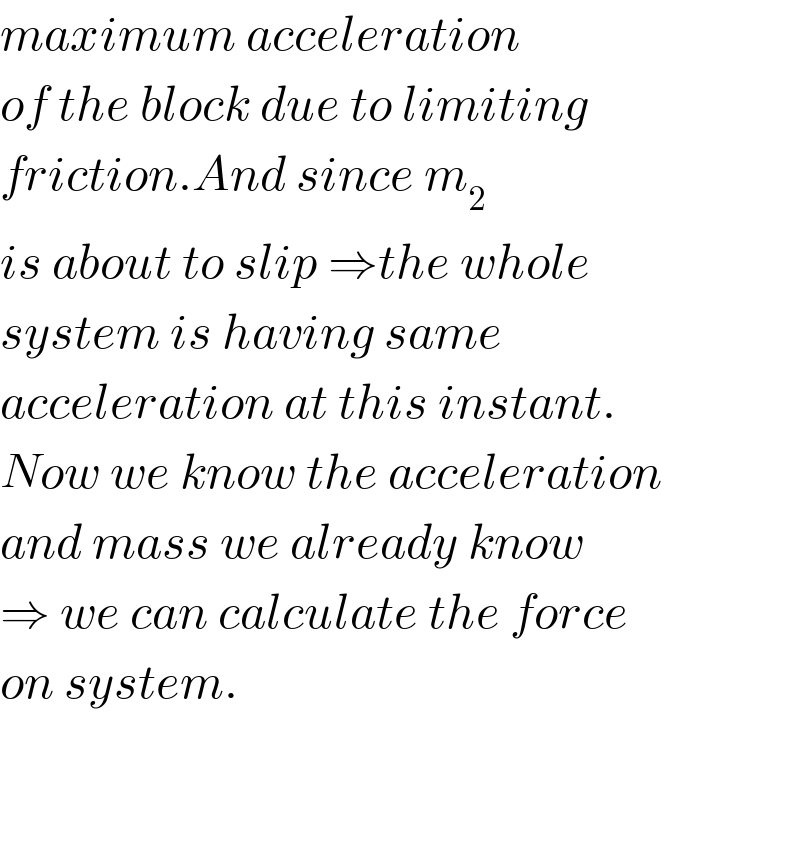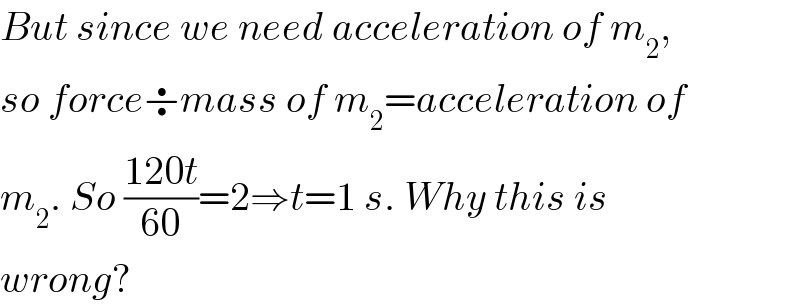
Question Number 22574 by Tinkutara last updated on 20/Oct/17

$$\mathrm{The}\:\mathrm{system}\:\mathrm{is}\:\mathrm{initially}\:\mathrm{at}\:\mathrm{origin}\:\mathrm{and}\:\mathrm{is} \\ $$$$\mathrm{moving}\:\mathrm{with}\:\mathrm{a}\:\mathrm{velocity}\:\left(\mathrm{3}\:\mathrm{m}/\mathrm{s}\right)\:\overset{\wedge} {{k}}.\:\mathrm{A} \\ $$$$\mathrm{force}\:\left(\mathrm{120}{t}\:\mathrm{newton}\right)\:\overset{\wedge} {{i}}\:\mathrm{acts}\:\mathrm{on}\:\mathrm{mass}\:{m}_{\mathrm{2}} , \\ $$$$\mathrm{where}\:{t}\:\mathrm{is}\:\mathrm{time}\:\mathrm{in}\:\mathrm{seconds}. \\ $$$$\mathrm{The}\:\mathrm{man}\:\mathrm{throws}\:\mathrm{a}\:\mathrm{light}\:\mathrm{ball},\:\mathrm{at}\:\mathrm{the} \\ $$$$\mathrm{instant}\:\mathrm{when}\:{m}_{\mathrm{1}} \:\mathrm{starts}\:\mathrm{slipping}\:\mathrm{on}\:{m}_{\mathrm{2}} , \\ $$$$\mathrm{with}\:\mathrm{a}\:\mathrm{velocity}\:\mathrm{5}\:\mathrm{m}/\mathrm{s}\:\mathrm{vertically}\:\mathrm{up}\:\mathrm{w}.\mathrm{r}.\mathrm{t} \\ $$$$\mathrm{himself}.\:\mathrm{Taking}\:\mathrm{the}\:\mathrm{masses}\:\mathrm{of}\:\mathrm{blocks} \\ $$$$\mathrm{and}\:\mathrm{man}\:\mathrm{as}\:\mathrm{60}\:\mathrm{kg}\:\mathrm{each}\:\mathrm{and}\:\mathrm{assuming} \\ $$$$\mathrm{that}\:\mathrm{the}\:\mathrm{man}\:\mathrm{never}\:\mathrm{slips}\:\mathrm{on}\:{m}_{\mathrm{2}} ,\:\mathrm{find} \\ $$$$\left(\mathrm{a}\right)\:\mathrm{The}\:\mathrm{time}\:\mathrm{at}\:\mathrm{which}\:\mathrm{man}\:\mathrm{throws}\:\mathrm{the} \\ $$$$\mathrm{ball}\:\mathrm{and} \\ $$$$\left(\mathrm{b}\right)\:\mathrm{The}\:\mathrm{coordinates}\:\mathrm{of}\:\mathrm{the}\:\mathrm{point}\:\mathrm{where} \\ $$$$\mathrm{ball}\:\mathrm{lands}.\:\mathrm{Neglect}\:\mathrm{the}\:\mathrm{dimensions}\:\mathrm{of} \\ $$$$\mathrm{the}\:\mathrm{system}.\:\left({g}\:=\:\mathrm{10}\:\mathrm{m}/\mathrm{s}^{\mathrm{2}} \right) \\ $$
Commented by Tinkutara last updated on 20/Oct/17

Answered by Sahib singh last updated on 21/Oct/17

$$ \\ $$$$ \\ $$$${if}\:\:\:\:\:\:\:\:{m}_{\mathrm{1}} =\:{m}_{\mathrm{2}} =\:{m}_{{man}} \\ $$$${v}_{{initial}} \:=\:\mathrm{3}\overset{\:} {\:}{k}\hat {\:}\:\:{m}/{s}\: \\ $$$$\mu\:=\:\mathrm{0}.\mathrm{2}\: \\ $$$$\Rightarrow\:{a}_{\:{maximum}\:{of}\:{m}_{\mathrm{2}} } \:=\:\frac{{F}_{{friction}} }{{m}_{\mathrm{2}} } \\ $$$$=\:\frac{\left(\mathrm{60}×\mathrm{0}.\mathrm{2}×\mathrm{10}\right){i}\hat {\:}}{\mathrm{60}}\:{m}/{s}^{\mathrm{2}} \\ $$$$=\mathrm{2}\:{i}\hat {\:}\:{m}/{s}^{\mathrm{2}} \\ $$$$\Rightarrow\:{when}\:{F}\:=\:\mathrm{360}\:{i}\hat {\:}\:{N} \\ $$$${as}\:{total}\:{mass}\:{is}\:\mathrm{180}\:{kg} \\ $$$$\Rightarrow\:{at}\:\:\:{t}\:=\:\mathrm{3}\:{s} \\ $$$${along}\:{x}\:{axis} \\ $$$$\:{F}\:=\:\mathrm{120}\:{t} \\ $$$$\Rightarrow\:\frac{{dp}}{{dt}}\:=\:\mathrm{120}\:{t} \\ $$$$\Rightarrow\:{dp}\:=\:\mathrm{120}\:{t}\:{dt} \\ $$$$\Rightarrow\:\int_{\mathrm{0}} ^{\:{v}} \:\:{dp}\:=\:\int_{\mathrm{0}\:} ^{\:\mathrm{3}} \:\mathrm{120}\:{t}\:{dt} \\ $$$$\Rightarrow\:{m}\Delta{v}\:=\:\mathrm{60}\:×\:\mathrm{9} \\ $$$$\Rightarrow\:\Delta{v}\:=\:\frac{\mathrm{60}×\mathrm{9}}{\mathrm{180}}\:=\:\mathrm{3}\:{i}\hat {\:}{m}/{s} \\ $$$$\Rightarrow\:{v}_{{man}} =\:\mathrm{3}\:{i}\hat {\:} \\ $$$$\& \\ $$$$\:\frac{{dx}}{{dt}}\:=\:\frac{{t}^{\mathrm{2}} }{\mathrm{3}} \\ $$$$\Rightarrow\:{x}_{{at}\:\:{t}\:=\:\mathrm{3}} \:=\:\mathrm{3}\: \\ $$$$\&\: \\ $$$${v}_{{z}} \:=\:\mathrm{3}\: \\ $$$$\Rightarrow\:{z}_{{at}\:\:{t}\:=\:\mathrm{3}} \:=\:\mathrm{9} \\ $$$$\Rightarrow\:\overset{\rightarrow} {{r}}_{{ball}\:{initially}} =\:\mathrm{3}{i}\hat {\:}+\mathrm{9}{k}\hat {\:} \\ $$$$ \\ $$$$\Rightarrow{v}_{{horizonral}\:{of}\:{ball}\:} =\left(\:\mathrm{3}{i}\hat {\:}+\mathrm{3}{k}\hat {\:}\right){m}/{s} \\ $$$$\Rightarrow\mid{v}_{{horizontal}} \mid\:=\:\mathrm{3}\sqrt{\mathrm{2}\:} \\ $$$$\Rightarrow\:{Range}\:=\:\frac{\mathrm{2}×\mid{v}_{{vertical}} \mid×\mid{v}_{{horizontal}} \mid}{{g}} \\ $$$$\Rightarrow\:{R}\:=\:\frac{\mathrm{2}×\mathrm{5}×\mathrm{3}\sqrt{\mathrm{2}}}{\mathrm{10}} \\ $$$$\Rightarrow\:{R}\left({in}\:{meters}\right)\:=\:\mathrm{3}\sqrt{\mathrm{2}} \\ $$$$\Rightarrow\:{as}\:{the}\:{horizontal}\:{velocity} \\ $$$${had}\:{direction}\:\left(\frac{\mathrm{3}{i}\hat {\:}+\:\mathrm{3}{k}\hat {\:}}{\mathrm{3}\sqrt{\mathrm{2}}}\right) \\ $$$$\Rightarrow\:\overset{\rightarrow\:} {{R}}\:{will}\:{also}\:{have}\:{same} \\ $$$${direction} \\ $$$$\Rightarrow\:{change}\:{in}\:{position}\:{vector}\:{of}\:{the}\: \\ $$$$\:{ball} \\ $$$$\overset{\rightarrow} {{r}}_{{final}} −\:\overset{\rightarrow} {{r}}_{{initial}} \:=\left(\mathrm{3}\:{i}\hat {\:}+\:\mathrm{3}\:{k}\hat {\:}\right)\:{m}\: \\ $$$$\Rightarrow\overset{\rightarrow} {{r}}_{{final}} =\:\left(\mathrm{6}\:{i}\hat {\:}\:+\:\mathrm{9}\:{k}\hat {\:}\right){m} \\ $$$$ \\ $$$$ \\ $$$$ \\ $$$$ \\ $$$$ \\ $$$$ \\ $$
Commented by Sahib singh last updated on 21/Oct/17

$${this}\:{is}\:{wrong}\:{because}\:{that} \\ $$$${external}\:{force}\:{is}\:{not}\: \\ $$$${accelerating}\:{block}\:{m}_{\mathrm{2}} . \\ $$$${Static}\:{frictional}\:{force}\:{is} \\ $$$${accelerating}\:{the}\:{block}. \\ $$$${theregore},\:{I}\:{solved}\:{for} \\ $$
Commented by Tinkutara last updated on 21/Oct/17

$$\left(\mathrm{3},\mathrm{0},\mathrm{3}\right)\:\mathrm{is}\:\mathrm{wrong}\:\mathrm{as}\:\mathrm{you}\:\mathrm{can}\:\mathrm{check}\:\mathrm{in}\:\mathrm{the} \\ $$$$\mathrm{Section}-\mathrm{H}. \\ $$
Commented by Sahib singh last updated on 21/Oct/17

$${ok}.{i}\:{will}\:{check} \\ $$
Commented by Sahib singh last updated on 21/Oct/17

$${oops}!\:{i}\:{made}\:{two}\:{mistakes}. \\ $$$${will}\:{rectify}\:\:{now}. \\ $$
Commented by Sahib singh last updated on 21/Oct/17

$${maximum}\:{acceleration} \\ $$$${of}\:{the}\:{block}\:{due}\:{to}\:{limiting} \\ $$$${friction}.{And}\:{since}\:{m}_{\mathrm{2}} \\ $$$${is}\:{about}\:{to}\:{slip}\:\Rightarrow{the}\:{whole} \\ $$$${system}\:{is}\:{having}\:{same}\: \\ $$$${acceleration}\:{at}\:{this}\:{instant}. \\ $$$${Now}\:{we}\:{know}\:{the}\:{acceleration} \\ $$$${and}\:{mass}\:{we}\:{already}\:{know} \\ $$$$\Rightarrow\:{we}\:{can}\:{calculate}\:{the}\:{force} \\ $$$${on}\:{system}. \\ $$$$ \\ $$$$ \\ $$
Commented by Tinkutara last updated on 21/Oct/17

$$\mathrm{Thank}\:\mathrm{you}\:\mathrm{Sir}! \\ $$
Commented by Sahib singh last updated on 21/Oct/17

$${now}\:{its}\:{fine}. \\ $$
Commented by Tinkutara last updated on 21/Oct/17

$${But}\:{since}\:{we}\:{need}\:{acceleration}\:{of}\:{m}_{\mathrm{2}} , \\ $$$${so}\:{force}\boldsymbol{\div}{mass}\:{of}\:{m}_{\mathrm{2}} ={acceleration}\:{of} \\ $$$${m}_{\mathrm{2}} .\:{So}\:\frac{\mathrm{120}{t}}{\mathrm{60}}=\mathrm{2}\Rightarrow{t}=\mathrm{1}\:{s}.\:{Why}\:{this}\:{is} \\ $$$${wrong}? \\ $$
Commented by Sahib singh last updated on 21/Oct/17

$$\left.{You}\:{are}\:{welcome}\::\right) \\ $$
